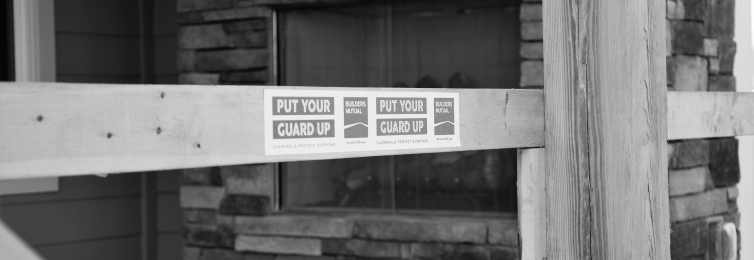By the time the average residential build is complete, 140 people will set foot on the job-site. If you take commercial job-sites into consideration, that number increases dramatically.
Planned and unplanned visitors.
There are usually two groups of people on your job-site. The first group includes your employees, sub-contractors, inspectors, and those making deliveries. Most of them are familiar with potential construction hazards, but accidents can happen to even the most experienced professionals.
The second group encompasses potentially unplanned visitors, including real estate agents, homeowners, trespassers, and children playing in houses under construction in their neighborhood. These are the “visitors” you may not think about when choosing whether to install guardrails.
Every year, Builders Mutual responds to costly General Liability claims when someone is injured from a fall on a job-site. Falls are the No. 1 type of claim that we see and while there are many types of falls, guardrails can often help prevent these injuries.
Not in the plans. Not in the timeline.
If you think about your current projects, are you certain that guardrails are in place? If you’re not sure, you’re not alone. Even on job-sites manned by seasoned professionals, guardrails are often missing around stairways, windows, and raised perimeters.
One reason for this omission in residential construction is that guardrails are simply not in the plans. It’s rare that the plans include measuring and ordering the amount of wood that’s needed for each opening – and it’s even less common that this is included in the budget ahead of time. As a result, workers often find themselves using scrap wood to install makeshift guardrails when they have time.
Additionally, your team is busy. Rough framing in particular is a fast-paced area of construction. Workers are in and out in a couple of days. This timeline can lead to guardrails being omitted, with contractors assuming that the opening will be protected or covered the next day. In the meantime, it takes only a second for an accident to happen.
Everyone should take responsibility for guardrails.
So, who is responsible for pointing out missing guardrails? For installing them? For planning ahead so they aren’t missed next time?
Ultimately, the general contractor is responsible for the structure. The GC should take the primary role of establishing when and where guardrails should go up. But we can all share in the duty to protect the site. All subcontractors and employees on the job-site have an obligation to speak up if they see missing rails. They, too, can be held responsible if someone is injured on their watch.
As changes are made on the site to keep the project moving forward, everyone should ask themselves if guardrails are needed at that stage. For example, if guardrails are up around an interior opening but are taken down to install drywall, then the workers at that spot must ensure the guardrails are put back up – even if this means switching to a free-standing boot-system.
Change job-site safety culture.
It takes only two minutes to install guardrails – and the results are well worth it. Falls that easily could have been prevented by proper guardrails result in injuries ranging from broken bones to death.
We need to change the culture surrounding guardrails to make them a must instead of a maybe. Here are some ways to start elevating your safety culture:
- Incorporate guardrail training into your new hire orientation. Explain why guardrails are important and how to install them properly.
- When you see a missing guardrail, address why it wasn’t installed and offer time for questions and answers.
- Ensure the younger generation gets the message. Typically, older, more seasoned workers attend tradeshows and industry meetings. Make sure they know to take learnings back to younger team members on the job-site.
Put your guard up.
To protect workers and job-site visitors alike, Builders Mutual and our partners are committed to increasing the use of guardrails. We want to empower every person on the job-site to take responsibility for guardrails and if a worker or visitor does not see guardrails in place, we want them to speak up. Guardrails are one of the few safety measures that protect everyone on a construction site.




 Find an
Find an